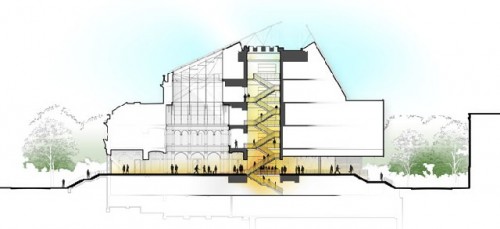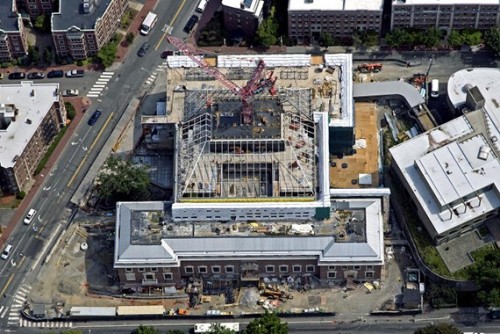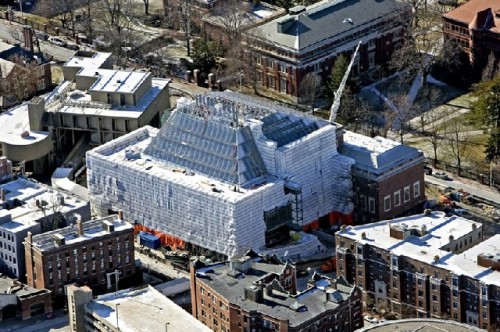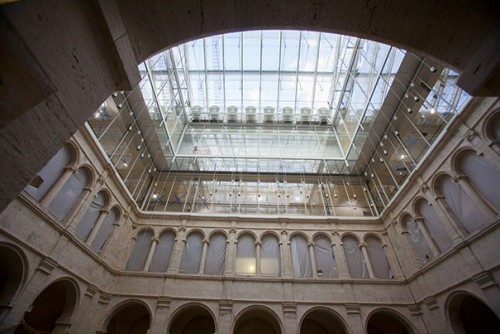Harvard Art Museums Open November 16
Renovation by Renzo Piano Conflates Separate Museums
By: Harvard - Mar 11, 2014
The Harvard Art Museums—comprising the Fogg Museum, the Busch-Reisinger Museum, and the Arthur M. Sackler Museum—will open their new Renzo Piano-designed facility to the public on November 16, 2014. The renovation and expansion of the museums’ landmark building at 32 Quincy Street in Cambridge will bring the three museums and their collections together under one roof for the ï¬rst time, inviting students, faculty, scholars, and the public into one of the world’s great institutions for arts scholarship and research. In the Harvard Art Museums’ new home, visitors will be able to explore new research connected to the objects on display and the ideas they generate in the galleries; gain a glimpse of leading conservators at work; and in the unique Art Study Center, have hands-on experiences with a wide range of objects from the collections.
To celebrate the opening, the Harvard Art Museums will host a suite of special events—engaging multiple groups, audiences, and supporters. The ï¬rst of these events will be a celebration for Harvard students in keeping with the museums’ mission of teaching and research as well as their role in supporting a broad range of teaching across disciplines at Harvard. Special events for faculty, donors, museum supporters, alumni, and others will follow, culminating in a preview for Cambridge residents ahead of the public opening celebration on Sunday, November 16.
“We are eagerly anticipating the opening of the new Harvard Art Museums facility,” said Harvard President Drew Gilpin Faust. “Renzo Piano has designed a building that is as beautiful as the works of art it will house and as thoughtful as the people who will work and learn within it. It will expand the ways in which we use art and art-making as part of the curriculum, and it will invite our neighbors and visitors to enjoy some of the University’s unparalleled treasures.”
The design for the new Harvard Art Museums creates new resources for study, teaching, exhibition, and conservation. The facility’s center, within the restored Calderwood Courtyard, will be a hub of activity and circulation. Mirroring an Italian piazza, or city square, the Calderwood Courtyard has been extended upward with glass arcades on the upper three floors and a new glass roof allowing controlled natural light into the heart of the building. Visitors can pass through the museums’ ground-floor public spaces, entering from either a new Prescott Street entrance or the original Quincy Street entrance, and can easily navigate the six levels of public space including galleries, the Art Study Center, classrooms and lecture halls, and a top floor offering views both into the heart of the facility and outside to Cambridge and Harvard Yard. The ground floor of the building, including a shop and cafe, will be open to the public without the purchase of admission.
The Harvard Art Museums have internationally renowned collections, which are among the largest art museum collections in the United States. Together, the collections of the Fogg Museum, the Busch-Reisinger Museum, and the Arthur M. Sackler Museum consist of approximately 250,000 objects dating from ancient times to the present, including objects from Europe, North America, the Mediterranean, and Asia across a variety of media. The Fogg Museum’s collection is known for its extensive holdings of European and American art. Strengths include Italian early Renaissance, 17th-century Dutch, and 19th-century French and British art, including one of America’s premier collections of works by the Pre-Raphaelites in addition to the celebrated Maurice Wertheim collection of impressionist and postimpressionist paintings. The museum also owns a signiï¬cant group of 19th- and 20th-century American paintings and works on paper, as well as important holdings of modern and contemporary sculpture and works in new media. The Busch-Reisinger Museum, the only museum of its kind in North America, is devoted solely to the art of central and northern Europe, with a particular emphasis on art from the German-speaking countries. The Busch-Reisinger collection holds signiï¬cant works of late medieval sculpture and allows for in-depth study of art after 1880, especially German expressionism, 1920s abstraction and the Bauhaus, as well as contemporary developments in all media. The Arthur M. Sackler Museum has one of the most signiï¬cant collections of Asian art in the West, with substantial holdings of archaic Chinese jades, ancient bronzes, Buddhist sculpture, ceramics, Japanese works on paper, and Korean art. It also includes important collections of Greek, Roman, Egyptian, and Near Eastern Art, a major numismatic collection, and paintings, ceramics, and extraordinary works on paper from Islamic lands and India.
The facility provides new and versatile platforms for accessing the collections: three distinct art study centers, special exhibition spaces, and the University galleries, which are programmed in consultation with faculty to support speciï¬c coursework or in partnership with other Harvard museums. The new exhibition galleries are designed speciï¬cally to create places for close engagement with individual works of art—for both the Harvard University community and the general public. Diverse, flexible spaces enable curators, students, and faculty to use the collections in ways that foster more dialogue and invite juxtapositions between objects from different cultures, time periods, and media. The renovation and expansion project has increased gallery space by 40 percent, for a total of approximately 43,000 square feet.
“We knew that we had an opportunity to redeï¬ne the Harvard Art Museums as an accessible and connected 21st-century facility for teaching and learning, so we engaged Renzo Piano to design a building to implement that vision,” said Thomas W. Lentz, Elizabeth and John Moors Cabot Director of the Harvard Art Museums. “We asked him to design it from the inside out—to create a new kind of laboratory for the ï¬ne arts that would support our mission of teaching across disciplines, conducting research, and training museum professionals. We also wanted to strengthen the museums’ role as an integral part of Cambridge and Boston’s cultural ecosystem. We look forward to welcoming students, faculty, and staff at Harvard, our Cambridge friends and neighbors, the entire Greater Boston community, and travelers from afar into our new home this November.”
Providing opportunities for the close, sustained viewing of works of art has long been central to the Harvard Art Museums’ mission of teaching and research. Only a small percentage of the museums’ collections can be displayed in public gallery spaces at any given time. Designed to offer an environment for individual study, the Art Study Center will provide distinct learning opportunities for students, faculty, and the public through the close examination of original works of art from the collections of the Fogg, Busch-Reisinger, and Arthur M. Sackler museums. Each of the three museums has its own dedicated art study center offering access to thousands of works of art across all media, including Greek vases, Roman bronze ï¬gurines, Byzantine coins, Chinese jades, Japanese surimono prints, Islamic miniatures, Rembrandt etchings, Paul Gauguin still lifes, David Smith sculpture, photographs by Diane Arbus, Lyonel Feininger drawings, or Joseph Beuys’s multiples. Visits can be arranged through advance appointment. The Art Study Center as a whole (including two seminar rooms and large reception and orientation areas) totals approximately 5,000 square feet and inhabits the fourth floor of the new facility, making it unique in size and scale among U.S. museums.
To date, the Harvard Art Museums have raised $237 million, 95 percent of the initial $250 million fundraising goal. Leadership philanthropic investments have been made by many signiï¬cant, long-time benefactors of Harvard, including Emily Rauh Pulitzer and Joseph Pulitzer, Jr., David Rockefeller, Richard and Ronay Menschel, and the Calderwood Charitable Foundation, among many others. Recent support includes a $5 million gift from the German Friends of the Busch-Reisinger Museum; a $2 million gift from Robert and Betsy Feinberg to name the Feinberg Art Study Center; and a $3 million gift from Marguerite Steed Hoffman to name the Art Study Center reception area. The project has also received support from the Massachusetts Cultural Facilities Fund, a state-funded agency, in recognition of the project’s value as a new public education resource. All funds contributed have been dedicated either to capital costs for construction and renovation or to building the endowment for operating costs.
About the Renovation and Expansion
Architect Renzo Piano’s design sensitively preserves the original 1927 Fogg Museum building, including its historic façades on Broadway and Quincy Street and the iconic interior Calderwood Courtyard. A new addition was constructed along Prescott Street, and a new glass roof allows controlled natural light to ï¬lter into the museums’ conservation labs and the Art Study Center, as well as into the central courtyard below. The renovation and expansion was designed to minimize impact on the historic structure; to add a new, distinct architectural expression; and to create a dialogue with the residential neighborhood and the adjacent Carpenter Center for the Visual Arts, the only building in North America designed by architect Le Corbusier. Construction on the exterior of the new 204,000-square-foot facility, begun in January 2010, is now complete. The project is designed to follow Harvard University’s sustainability initiatives, with the intention of attaining LEED Gold certiï¬cation. Work on the interior of the building will continue through the fall of 2014, including several months to condition the facility for climate control and other building systems and to reinstall the collections. The renovation and expansion will increase the Harvard Art Museums’ gallery space by more than 40 percent; the addition of 12,000 square feet brings the total exhibition space to 43,000 square feet. wHY Architecture has worked with curators and senior leaders of the Harvard Art Museums on the design for the inaugural installation of the permanent collection galleries, as well as on plans for how these spaces can be reconï¬gured or changed over time as works of art are rotated. Payette Associates is the Architect of Record and local design partner, and Skanska USA served as construction manager of the project.
Key elements of the expansion and renovation include:
• Art Study Center: A central feature of the new facility, the Art Study Center will provide distinct areas for study and research, offering students, faculty, and the public purpose-built environments for learning through the close examination of original works of art from the collections of the Fogg, Busch-Reisinger, and Arthur M. Sackler museums.
• Calderwood Courtyard: The historic heart of the original Fogg Museum, the courtyard has been restored as the central point of circulation in the museums’ new home. It will be open to the public free of charge. The renovation and expansion project preserves both the design of the historic courtyard and its function as the center of activity and circulation. The design opens up all of the courtyard’s ground-floor arcades, allowing visitors to move freely through the new facility, from galleries in the original Fogg Museum structure to the Busch-Reisinger Museum and Arthur M. Sackler Museum galleries in the new addition. The revitalized courtyard also offers interior views through the ï¬ve upper levels of the facility.
• Straus Center for Conservation and Technical Studies: The Harvard Art Museums are home to the ï¬rst ï¬ne arts conservation, research, and training facility established in the United States. Visitors can gain a glimpse of the conservation and research activity under way in the glass-walled Straus Center, located on the building’s uppermost level.
• New Exhibition Galleries: Expanded permanent collection and special exhibition galleries will be complemented by University galleries, programmed in consultation with faculty to support speciï¬c coursework. These University galleries, which are open to the public, can also be used for curatorial studies and training or to provide additional space to support the Art Study Center.
• Lightbox Gallery: This new gallery space on the top level of the Harvard Art Museums will showcase the intersections of art and technology. The Lightbox Gallery also offers a unique perspective on key spaces and functions, from oblique views into conservation labs, to close-up perspectives on the technical aspects of the glass roof, including its louvers and shades, to a bird’s-eye view down through the building into the historic Calderwood Courtyard.
• Lecture Halls and Seminar Rooms: There is a 300-seat lecture hall for presentations, performances, and events on the new lower level. This and other lecture and classroom spaces will be activated by Harvard faculty and students as well as through public programs and events.
• Materials Lab: Located on the lower level, this space will be dedicated to exploring material ingenuity and innovations in art media. The hands-on, active learning experiences conducted will be based on works of art on view in the galleries and in the Art Study Center on the floors above.
• Museum shop and cafe: The shop and cafe, designed by leading interior designers Charles Sparks + Company, will be located off the Calderwood Courtyard on the ï¬rst floor as part of a new open circulation path through the building. Visitors will be able to enter the new facility from either the original entrance on Quincy Street or the new entrance on Prescott Street, both leading to the courtyard with direct access to the shop and cafe. Visitors will have access to the shop and cafe without the purchase of admission.
For details on the renovation and expansion project, visit magazine.harvardartmuseums.org/tag/renovation.
About the Project Team
Pritzker Prize–winning architect Renzo Piano and the Renzo Piano Building Workshop (RPBW) created a design that preserves the original historic building at 32 Quincy Street while providing new space to support the expanding programs necessary to fulï¬ll the Harvard Art Museums’ teaching and research mission. Piano has designed for many critically acclaimed museums around the world, including the expansions of the Art Institute of Chicago, the Los Angeles County Museum of Art, and the Kimbell Art Museum, as well as the Isabella Stewart Gardner Museum, The Menil Collection, The Morgan Library & Museum, and the Nasher Sculpture Center. Renzo Piano Building Workshop is particularly known for the ï¬rm’s thoughtful renovations of historic structures. rpbw.com
Payette is the Architect of Record and local design partner collaborating with RPBW on the Harvard Art Museums project. A leading architectural design ï¬rm in Boston, Payette focuses on technologically and programmatically complex buildings for scientiï¬c research, higher education, health care, and corporate research clients. payette.com
Skanska USA served as the construction manager for the Harvard Art Museums project. Skanska USA is one of the largest construction and development companies in the country, with expertise in construction, infrastructure, public/private partnerships, and commercial and infrastructure development initiatives. usa.skanska.com
wHY Architecture created the design for the inaugural installation of the permanent collection galleries. Founded in 2004 and led by Creative Director Kulapat Yantrasast, wHY is a team of 40 creative designers with offices in Los Angeles, New York, and Louisville. why-site.com
About the Harvard Art Museums
The Harvard Art Museums, among the world’s leading art institutions, comprise three museums (Fogg, Busch-Reisinger, and Arthur M. Sackler) and four research centers (Straus Center for Conservation and Technical Studies, the Center for the Technical Study of Modern Art, the Harvard Art Museums Archives, and the Archaeological Exploration of Sardis). The Fogg Museum is dedicated to Western art from the Middle Ages to the present; the Busch-Reisinger Museum focuses on works from central and northern Europe with a special emphasis on the art of German-speaking countries; and the Arthur M. Sackler Museum is dedicated to Asian, ancient, and Islamic and later Indian art. Together, the collections include approximately 250,000 objects in all media. The Harvard Art Museums are distinguished by the range and depth of their collections, their groundbreaking exhibitions, and the original research of their staff. Integral to Harvard University and the wider community, the museums and research centers serve as resources for students, scholars, and the public. For more than a century, they have been the nation’s premier training ground for museum professionals and are renowned for their seminal role in developing the discipline of art history. harvardartmuseums.org.








